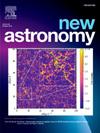TESS light curves and period changes in low-mass eclipsing binary BB Persei
IF 2.1
4区 物理与天体物理
Q2 ASTRONOMY & ASTROPHYSICS
引用次数: 0
Abstract
We present a detailed analysis of the low-mass detached eclipsing binary system BB Persei, which contains two K-type stars in a circular orbit with a short period of 0.4856 d. We used light curves from the Transiting Exoplanet Survey Satellite (Tess), which observed BB Per in five sectors, to determine its photometric properties and a precise orbital ephemeris. The solution of the Tess light curve in Phoebe results in a detached configuration, where the temperature of the primary component was fixed to K according to Lamost, which gives us K for the secondary. The spectral type of the primary component was derived as K0 and the photometric mass ratio was estimated . Slow period changes on the current O-C diagram spanning the past 25 years indicate the presence of a third body orbiting the eclipsing pair with an orbital period of about 22 years. The companion could be a red dwarf of spectral type M6–M7 with a minimal mass of about 0.1 M. The characteristics and temporal variation of the dark region on the surface of the secondary component were estimated.
低质量食双星英仙座BB的TESS光曲线和周期变化
我们对低质量分离的双星系统BB英仙座进行了详细的分析,该系统包含两颗k型恒星,在一个周期为0.4856 d的圆形轨道上运行。我们使用了凌日系外行星测量卫星(Tess)的光曲线,该卫星在五个扇区观测BB Per,以确定其光度特性和精确的轨道星历。菲比中Tess光曲线的解得到一个分离的结构,其中主成分的温度根据Lamost固定为T1=5300 K,这就得到了次成分的T2=5050±50 K。主成分的光谱类型为K0,光度质量比估计为q=0.90。在过去的25年里,当前的O-C图上缓慢的周期变化表明存在第三个天体,其轨道周期约为22年。伴星可能是一颗光谱型为M6-M7的红矮星,最小质量约为0.1 M⊙。估算了二次分量表面暗区的特征和时间变化。
本文章由计算机程序翻译,如有差异,请以英文原文为准。
求助全文
约1分钟内获得全文
求助全文
来源期刊

New Astronomy
地学天文-天文与天体物理
CiteScore
4.00
自引率
10.00%
发文量
109
审稿时长
13.6 weeks
期刊介绍:
New Astronomy publishes articles in all fields of astronomy and astrophysics, with a particular focus on computational astronomy: mathematical and astronomy techniques and methodology, simulations, modelling and numerical results and computational techniques in instrumentation.
New Astronomy includes full length research articles and review articles. The journal covers solar, stellar, galactic and extragalactic astronomy and astrophysics. It reports on original research in all wavelength bands, ranging from radio to gamma-ray.
 求助内容:
求助内容: 应助结果提醒方式:
应助结果提醒方式:


